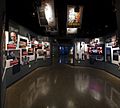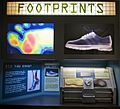National Museum of Crime and Punishment facts for kids
| Lua error in Module:Location_map at line 420: attempt to index field 'wikibase' (a nil value). | |
| Established | May 23, 2008 |
|---|---|
| Dissolved | September 30, 2015 |
| Location | 575 7th Street NW, Washington, D.C., USA |
The National Museum of Crime and Punishment, also known as the Crime Museum, was a special museum in Washington, D.C.. It was all about the history of crime and how people were punished in the United States. The museum opened in May 2008 and closed its doors in September 2015.
This museum was different from many others in Washington, D.C., because it was a private business. It was created by John Morgan, a businessman from Orlando, Florida, along with John Walsh, who hosted the TV show America's Most Wanted. Building the museum cost about $21 million. Today, a new version of the museum, called Alcatraz East, is open in Pigeon Forge, Tennessee.
The museum had over 700 items spread across a large area. These items showed the history of crime and its effects in America. It also explored how crime has been shown in American movies and stories. Visitors could see exhibits about pirates, famous outlaws from the Wild West, and gangsters. There were also 28 interactive stations. These included police chase simulators, like those used to train real police officers. There was also a special shooting simulator, similar to what the FBI uses for training.
Contents
Exploring the Museum's Exhibits
The museum had many interesting areas to explore. Each section helped visitors learn about different parts of crime and law enforcement.
Solving a Mystery: The Crime Scene Lab
On the main floor, there was a pretend crime scene. It looked like a simulated murder had happened. Visitors could act like detectives and learn how to solve the crime. They used real forensic science techniques. This included looking at bullet marks, blood, fingerprints, and footprints. They could even try to rebuild faces or dental records to identify people.
Inside a Police Station and Jail
The museum also had a mock police station. Here, you could see what a booking room looks like. There were also funny celebrity mug shots and a police line-up. You could even try a lie detector test! The museum showed art made by prisoners and tools they used to try and escape. There was a re-creation of the jail cell where famous gangster Al Capone was held in Philadelphia.
Heroes of Law Enforcement
Another part of the museum honored crime fighters. It featured important figures like J. Edgar Hoover, the first director of the FBI, and the legendary agent Eliot Ness. You could see uniforms, firearms, and special equipment used by police officers. There were also exhibits on bomb squads and night vision technology.
America's Most Wanted Studio Experience
For a while, the museum was also where the TV show America's Most Wanted was filmed. This started in 2008. Later, when the show began filming in different locations, the studio became an interactive exhibit. Visitors could try to solve a pretend crime themselves. Around the studio, there were exhibits about the National Center for Missing and Exploited Children. There was also information about McGruff the Crime Dog, who teaches kids about crime prevention. A special station allowed children to get digital fingerprints and ID cards.
Fun and Interactive Attractions
The museum offered many hands-on activities for visitors:
- Crime Scene Lab: Step into a pretend crime scene and work to solve the case.
- Agent Training: Practice your aim in a simulated shooting range, just like agents do.
- Police Chase Simulator: Experience a high-speed police pursuit in a training simulator.
- Real Items: See an electric chair, prison art, and actual jail cells.
- Famous Lawbreakers: Learn about legendary pirates, gangsters, and outlaws from the Wild West.
- Digital Fingerprinting: Kids could get their fingerprints taken and receive a printout ID card.
- TV Studio: Explore the set of America's Most Wanted and interact with a virtual John Walsh.
Images for kids















